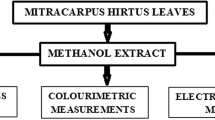Abstract
The inhibition effect of Jasminum nudiflorum Lindl. leaves extract (JNLLE) on the corrosion of cold rolled steel (CRS) in 1.0 M hydrochloric acid (HCl) was investigated by weight loss, potentiodynamic polarization, and electrochemical impedance spectroscopy (EIS) methods. The results show that JNLLE acts as a very good inhibitor, and the inhibition efficiency increases with the concentration of JNLLE. The adsorption of JNLLE obeys Langmuir adsorption isotherm. Values of inhibition efficiency obtained from weight loss, potentiodynamic polarization, and electrochemical impedance spectroscopy (EIS) are in good agreement. Polarization curves show that JNLLE behaves as a mixed-type inhibitor in hydrochloric acid. EIS shows that charge-transfer resistance increase and the capacitance of double layer decreases with the inhibitor concentration, confirming the adsorption process mechanism. The adsorbed film on CRS surface containing JNLLE inhibitor was also measured by Fourier transform infrared spectroscopy (FTIR) and scanning electron microscope (SEM). A probable inhibitive mechanism is proposed from the viewpoint of adsorption theory.









Similar content being viewed by others
References
Bentiss F, Traisnel M, Lagrenée M (2000) Corros Sci 42:127
Trabanelli G (1991) Corrosion 47:410
Singh DDN, Singh TB, Gaur B (1995) Corros Sci 37:1005
Zhang TS (2002) Corrosion inhibitors. Chemical Industrial Engineering Press, Beijing (in Chinese)
Ekpe UJ, Ebenso EE, Ibok UJ (1994) J West African Assoc 37:13
Loto CA (1998) Niger Corros J 19:20
Al-Sehaibani H (2000) Mater Wissen Werkst Technol 31:1060
Chetouani A, Hammouti B (2001) Bull Electrochem 19:23
Orubite KO, Oforka NC (2004) Mater Lett 58:1768
Gunasekaran G, Chauhan LR (2004) Electrochim Acta 49:4387
Chuanhan LR, Gunasekaran G (2007) Corros Sci 49:1143
Abdel-Gaber AM, Abd-El Nabey BA, Sidahmed IM, El-Zayady AM, Saadawy M (2006) Corrosion 62:293
Bouyanzer A, Hammouti B, Majidi L (2006) Mater Lett 60:2840
El-Etre AY (2007) J Colloid Interface Sci 314:578
Okafor PC, Ikpi ME, Uwah IE, Ebenso EE, Ekpe UJ, Umoren SA (2008) Corros Sci 50:2310
Oguzie EE (2008) Corros Sci 50:2993
Oguzie EE (2006) Mater Chem Phys 99:441
Abdel-Gaber AM, Abd-El-Nabey BA, Saadawy M (2009) Corros Sci 51:1038
Eddy NO, Odoemelam SA, Odiongenyi AO (2009) J Appl Electrochem 39:849
Raja PB, Sethuraman MG (2009) Mater Corros 60:22
Zheng MY, Wei YS (2003) Nat Prod Res Dev 15:494
Yang WB, Lu CY, Chen GX, Li GZ, Zhang M (2008) Food Sci 29:474 (in Chinese)
Zhang ZX (2000) J Wenshan Teach Coll 19:97 (in Chinese)
Li XH, Mu GN (2005) Appl Surf Sci 252:1254
Li XH, Deng SD, Fu H, Li TH (2009) Electrochim Acta 54:4089
Sekine I, Hirakawa Y (1986) Corrosion 42:272
Li XH, Deng SD, Fu H, Mu GN (2009) J Appl Electrochem 39:1125
Cao CN (2004) Corrosion electrochemistry mechanism. Chemical Engineering Press, Beijing, p 235 (in Chinese)
Larabi L, Harek Y, Traisnel M, Mansri A (2004) J Appl Electrochem 34:833
Lebrini M, Lagrenée M, Vezin H, Traisnel M, Bentiss F (2007) Corros Sci 49:2254
Priya ARS, Muralidharam VS, Subramania A (2008) Corrosion 64:541
Bommersbach P, Alemany-Dumont C, Millet JP, Normand B (2006) Electrochim Acta 51:4011
Qu Q, Jiang SA, Bai W, Li L (2007) Electrochim Acta 52:6811
Lagrenée M, Mernari B, Bouanis M, Traisnel M, Bentiss F (2002) Corros Sci 44:573
Lalitha A, Ramesh S, Rajeswari S (2005) Electrochim Acta 51:47
Manov S, Lamazouère AM, Ariès L (2000) Corros Sci 42:1235
Liao DW, Lin ZY, KhR Tsai (1996) J Xiamen Univ 35:734 (in Chinese)
Takenaka T, Tahanashi T, Taguchi H, Nagakura N (2002) Chem Pharm Bull 50:384
Tang LB, Li XM, Li L, Mu GN, Liu GH (2006) Surf Coat Technol 201:384
Acknowledgments
This study was carried out in the scope of research project funded by Key Laboratory for Forest Resources Conservation and Use in the Southwest Mountains of China (Southwest Forestry University) Ministry of Education, Key Construction Course of Chemical Engineering for Forest Products of Southwest Forestry University (XKX200907). The electrochemical measurements were carried out using PARSTAT 2273 advanced electrochemical system (Princeton Applied Research) provided by Advanced Science Instrument Sharing Center of Southwest Forestry University.
Author information
Authors and Affiliations
Corresponding author
Rights and permissions
About this article
Cite this article
Li, XH., Deng, SD. & Fu, H. Inhibition by Jasminum nudiflorum Lindl. leaves extract of the corrosion of cold rolled steel in hydrochloric acid solution. J Appl Electrochem 40, 1641–1649 (2010). https://doi.org/10.1007/s10800-010-0151-5
Received:
Accepted:
Published:
Issue Date:
DOI: https://doi.org/10.1007/s10800-010-0151-5




